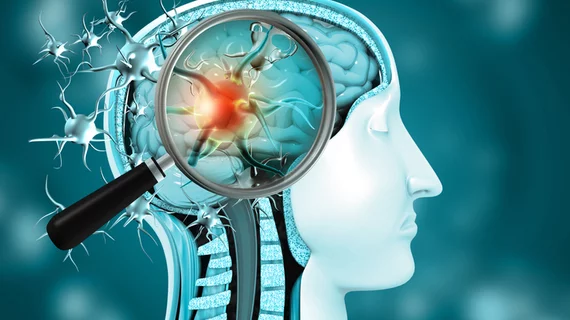Know your ARIAs: Radiologists urged to learn telltale signs of Alzheimer’s drugs that target amyloid plaques
Radiologists need to familiarize themselves with the appearance of brain abnormalities on MRI that may trace to treatment with amyloid-fighting drugs in the quickly emerging category of monoclonal antibodies.
This goes for generalists as well as neuroradiologists.
So state researchers in a white paper published in the August edition of the American Journal of Neuroradiology [1].
Called ARIAs for amyloid-related imaging abnormalities, the findings tend to appear as one of two types, ARIA-E for those that have edema or effusion and ARIA-H for those with hemorrhage or hemosiderosis (iron buildup).
Lead author Petrice Cogswell, MD, PhD, of the Mayo Clinic and colleagues note that the efficacy of an early release in the drug category, aducanumab, may be disputed, but its notoriety has surely accelerated the pace of development in the amyloid-busters pipeline.
“Given the large number of AD therapeutic candidates, implementation of treatment and monitoring may greatly increase neuroradiology practice volumes,” the authors write.
Along with getting to know how these new drugs work on targets and look on scans, they suggest, radiology generalists as well as neuroradiologists do well to learn about pitfalls in interpretation of ARIAs, best practices for selecting imaging protocols, and expert recommendations on reporting these findings in clinical practice in a standardized manner.
Cogswell and co-authors spend the balance of their paper—essentially a thorough primer on ARIA—fleshing out each of those components.
Here are a few summary highlights.
‘ARIA’ Terminology Origin and Reimbursement Status
A workgroup convened by the Alzheimer’s Association Research Roundtable coined the acronym for amyloid-related imaging abnormalities as far back as 2010. Workgroup members had in mind supplying information and recommendations around ARIAs that had been showing up in anti-amyloid trials.
Along with aducanumab, which FDA cleared in June 2021, “multiple monoclonal antibodies with variable targets and incidence of ARIA have since been developed and tested in clinical trials,” Cogswell and colleagues point out. “Other agents (donanemab, lecanemab, gantenerumab) are currently in late-phase clinical trials and will undergo similar FDA reviews.”
More:
The Centers for Medicare and Medicaid Services currently proposes coverage for FDA-approved anti-amyloid monoclonal antibodies in CMS-approved randomized control trials. To date, uncertainties remain on several fronts including the presence and extent of insurance coverage, the results of an anticipated Phase IV confirmatory study required by the FDA, multiple stakeholder preparedness across a wide range of clinical practices and other factors.”
ARIA Mechanism
Cogswell and colleagues explain that amyloid deposition in vessel walls (aka cerebral amyloid angiopathy, or CAA) can compromise vascular integrity, reduce normal drainage in the vascular wall and, in cases, cause microhemorrhages.
“When anti-amyloid monoclonal antibody therapy is initiated, antibody-mediated breakdown of amyloid plaque and mobilization of parenchymal and vascular amyloid-beta increase the load of perivascular drainage,” they write. “The overload of perivascular drainage pathways may transiently increase amyloid deposition in the arterial wall.” More:
At the same time, antibody-mediated inflammation and breakdown of amyloid also occur in the vessel wall. These processes cause further loss of vascular integrity and blood-brain barrier breakdown. As a result, proteinaceous fluid and/or red blood cells leak … and result in edema/effusion (ARIA-E) or microhemorrhages/superficial siderosis (ARIA-H).”
ARIA-E Clinical Consequences
The most frequently detected ARIA type on routine surveillance MRI in asymptomatic patients, ARIA-E may manifest as specific signs in those who do present with symptoms. These might include headache, confusion, visual disturbances and visuospatial impairment, Cogswell and co-authors state.
“Like the imaging findings, the clinical symptoms are generally expected to resolve over time with treatment pause or withdrawal,” they add. More:
In the rare event of symptomatic ARIA-E or in cases with asymptomatic radiographically severe ARIA-E, treatment with intravenous methylprednisolone and possibly other therapies (eg, antihypertensives, anti-seizure medications) may be indicated on the basis of anecdotal reports.”
The emerging monoclonal antibody therapies for Alzheimer’s disease “require both baseline pretreatment brain MR imaging and frequent monitoring MR imaging examinations for the detection of potential subclinical adverse events that may require dose adjustment,” Cogswell et al. conclude.
“As these therapies begin to be implemented in clinical practice, treatment enrollment and monitoring brain MR imaging examinations may greatly increase neuroradiology practice volumes and will introduce a new imaging entity, ARIA, requiring awareness by all radiologists.”
AJNR has posted the paper in full for free.

